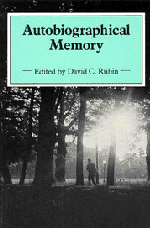Book contents
- Frontmatter
- Contents
- List of contributors
- Preface
- Part I Overview
- Part II Historical, theoretical, and methodological contexts for the study of autobiographical memory
- Part III The general organization of autobiographical memory
- Part IV The temporal organization of autobiographical memory
- 9 Public memories and their personal context
- 10 Temporal reference systems and autobiographical memory
- Part V Temporal distributions of autobiographical memories
- Part VI Failures of autobiographical memory
- Author index
- Subject index
10 - Temporal reference systems and autobiographical memory
Published online by Cambridge University Press: 01 March 2011
- Frontmatter
- Contents
- List of contributors
- Preface
- Part I Overview
- Part II Historical, theoretical, and methodological contexts for the study of autobiographical memory
- Part III The general organization of autobiographical memory
- Part IV The temporal organization of autobiographical memory
- 9 Public memories and their personal context
- 10 Temporal reference systems and autobiographical memory
- Part V Temporal distributions of autobiographical memories
- Part VI Failures of autobiographical memory
- Author index
- Subject index
Summary
Introduction and theoretical orientation
Everyday life is dominated by routines. The flow of action is structured by the recurrent requirements of our society. We work, play, and worship according to timetables that have evolved over centuries and that provide a shared temporal framework for our individual histories. The way we understand time is derived from the social and institutional regulation of action. Although we use clocks and calendars to mark time, we do not experience time as the succession of uniform units of duration. Rather, we experience time as action, and succession as either the repetition of an action or a change from one activity to another. When we have no prescribed activity to perform, as during vacations or in retirement, we may lose track of time or experience a sense of timelessness. Time and action codefine each other, and both are organized through the institutions of society.
Each person engages in a variety of socially regulated activities (e.g., work, schooling, recreation, worship). For convenience I will refer to these various activities as domains of action. I think it is self-evident that participation in a domain of action engenders an appropriate cognitive representation of the temporal pattern associated with it. Viewed as socially prescribed routines, these patterns function as timetables (or schedules or calendars). I shall refer to the cognitive representations of such timetables as temporal reference systems. These representations are schemata that codify when and in what order activities occur for a given domain of action.
- Type
- Chapter
- Information
- Autobiographical Memory , pp. 159 - 188Publisher: Cambridge University PressPrint publication year: 1986
- 52
- Cited by

